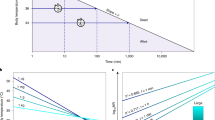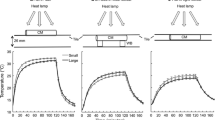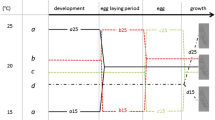Abstract
Ectotherms increase in size dramatically during development, and this growth should have substantial effects on their body temperature and ability to thermoregulate. To better understand how this change in size affects temperature, we examined the direct effects of body size on body temperature in Battus philenor caterpillars, and also how body size affects both the expression and effectiveness of thermal refuge-seeking, a thermoregulatory behavior. Field studies of both live caterpillars and physical operative temperature models indicated that caterpillar body temperature increases with body size. The operative temperature models also showed that thermal refuges have a greater cooling effect for larger caterpillars, while a laboratory study found that larger caterpillars seek refuges at a lower temperature. Although the details may vary, similar connections between developmental growth, temperature, and thermoregulation should be common among ectotherms and greatly affect both their development and thermal ecology.




Similar content being viewed by others
References
Atkinson D (1994) Temperature and organism size—a biological law for ectotherms? Adv Ecol Res 25:1–58
Bakken GS (1992) Measurement and application of operative and standard operative temperatures in ecology. Am Zool 32:194–216
Bakken GS, Santee WR, Erskine DJ (1985) Operative and standard operative temperature: tools for thermal energetics studies. Am Zool 25:933–943
Berger D, Friberg M, Gotthard K (2011) Divergence and ontogenetic coupling of larval behaviour and thermal reaction norms in three closely related butterflies. Proc R Soc B 278:313–320
Bogert CM (1949) Thermoregulation in reptiles, a factor in evolution. Evolution 3:195–211
Carrascal LM, López P, Martín J, Salvador A (1992) Basking and antipredator behaviour in a high altitude lizard: implications of heat-exchange rate. Ethology 92:143–154
Casey TM (1976) Activity patterns, body temperature and thermal ecology in two desert caterpillars (Lepidoptera: Sphingidae). Ecology 57:485–497
Forster J, Hirst AG (2012) The temperature-size rule emerges from ontogenetic differences between growth and development rates. Funct Ecol 26:483–492
Huey RB, Slatkin M (1976) Costs and benefits of lizard thermoregulation. Q Rev Biol 51:363–384
Kingsolver JG, Huey RB (2008) Size, temperature, and fitness: three rules. Evol Ecol Res 10:251–268
Le Lagdec MD, Chown SL, Scholtz CH (1998) Desiccation resistance and water balance in southern African keratin beetles (Coleoptera, Trogidae): the influence of body size and habitat. J Comp Physiol B 168:112–122
Lighton JRB, Quinlan MC, Feener DH Jr (1994) Is bigger better? water balance in the polymorphic desert harvester ant Messor pergandei. Physiol Entomol 19:325–334
Morita K, Fukuwaka M, Tanimata N, Yamamura O (2010) Size-dependent thermal preferences in a pelagic fish. Oikos 119:1265–1272
Nice C, Fordyce J (2006) How caterpillars avoid overheating: behavioral and phenotypic plasticity of pipevine swallowtail larvae. Oecologia 146:541–548
Papaj DR, Newsom GM (2005) A within-species warning function for an aposematic signal. Proc R Soc B 272:2519–2523
Pincebourde S, Woods HA (2012) Climate uncertainty on leaf surfaces: the biophysics of leaf microclimates and their consequences for leaf-dwelling organisms. Funct Ecol 26:844–853
Porter WP, Gates DM (1969) Thermodynamic equilibria of animals with environment. Ecol Monogr 3:227–244
Porter WP, James FC (1979) Behavioral implications of mechanistic ecology. II. The African rainbow lizard, Agama agama. Coepia 1979:594–619
Porter WP, Mitchell JW, Beckman WA, DeWitt CB (1973) Behavioral implications of mechanistic ecology. Oecologia 13:1–54
Potter K, Davidowitz G, Woods HA (2009) Insect eggs protected from high temperatures by limited homeothermy of plant leaves. J Exp Biol 212:3448–3454
Rausher MD (1979) Egg recognition: its advantage to a butterfly. Anim Behav 27:1034–1040
Reavey D (1993) Why body size matters to caterpillars. In: Stamp NE, Casey TM (eds) Caterpillars: ecological and evolutionary constraints on foraging. Chapman & Hall, New York, pp 248–279
Scott RL, Jenerette GD, Potts DL, Huxman TE (2009) Effects of seasonal drought on net carbon dioxide exchange from a woody-plant-encroached semiarid grassland. J Geophys Res 114:G04004
Stevenson R (1985a) Body size and limits to the daily range of temperature in terrestrial ectotherms. Am Nat 125:102–117
Stevenson R (1985b) The relative importance of behavioral and physiological adjustments controlling body temperature in terrestrial ectotherms. Am Nat 126:362–386
Stower WJ, Griffiths JF (1966) The body temperature of the desert locust Schistocerca gregaria. Entomol Exp Appl 9:127–178
Weis SB, Murphy DD (1988) Fractal geometry and caterpillar dispersal: or how many inches can inchworms inch? Funct Ecol 2:116–118
Willmer PG, Unwin DM (1981) Field analyses of insect heat budgets: reflectance, size and heating rates. Oecologia 50:250–255
Woods HA (2013) Ontogenetic changes in the body temperature of an insect herbivore. Funct Ecol 27:1322–1331
Zuo W, Moses ME, West GB, Hou C, Brown JH (2012) A general model for effects of temperature on ectotherm ontogenetic growth and development. Proc R Soc B 279:1840–1846
Acknowledgments
First, we would like to thank Karen Gonzalez and Angelina Uribe for assistance conducting the experiments and Dr Joel Kingsolver for advice in designing the caterpillar models. We would also like to thank Danfeng Wang, Dr Carla Essenberg, Dr Joel Kingsolver and three anonymous reviewers for comments on the manuscript. This material is based upon work supported by the National Science Foundation Graduate Research Fellowship under grant no. DGE-1143953. Any opinion, findings, and conclusions or recommendations expressed in this material are those of the authors and do not necessarily reflect the views of the National Science Foundation.
Conflict of interest
This research complies with the current laws of the United States of America. The authors declare that they have no conflict of interest.
Author information
Authors and Affiliations
Corresponding author
Additional information
Communicated by Thomas S. Hoffmeister.
Rights and permissions
About this article
Cite this article
Nielsen, M.E., Papaj, D.R. Effects of developmental change in body size on ectotherm body temperature and behavioral thermoregulation: caterpillars in a heat-stressed environment. Oecologia 177, 171–179 (2015). https://doi.org/10.1007/s00442-014-3123-3
Received:
Accepted:
Published:
Issue Date:
DOI: https://doi.org/10.1007/s00442-014-3123-3




